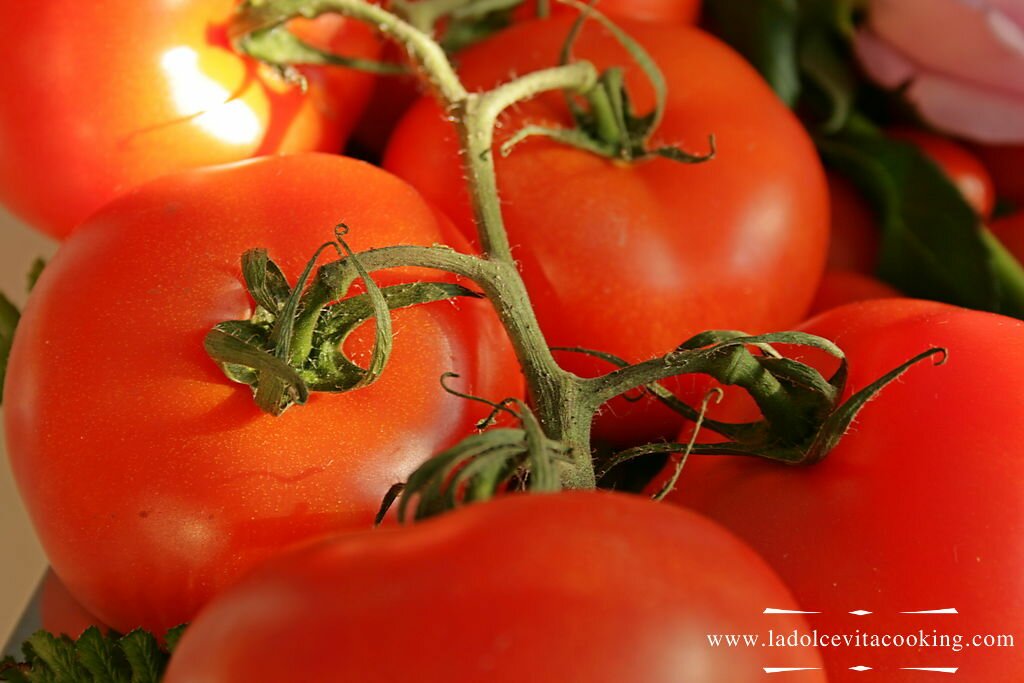Ma tu vuliv'a'pizza a'pizza a'pizza ca pummarola n'coppa ca pummarola n'coppa. Ma tu vuliv'a'pizza a'pizza a'pizza ca pummarola n'coppa a'pizza e niente cchiù.
But you wanted nothing else than a pizza with the tomato on top, sings a popular song in a Naples in love. Honestly for a Neapolitan, and for all the Italian people as well, it's impossible to cook without the beautiful color and flavor of the pummarola (Neapolitan) or pomodoro (Italian).

We saw the tomato for the first time in the XVI century thanks to the Spanish that brought it to Europe from America, where the tomato is native. Since pre-Columbian times in Mexico and Peru the cultivation of the tomato plant was well known, but only for ornamental purposes.
Down there, nobody ate tomatoes (tomatl in the Aztec language) and that is how tomato was known to the Spanish. So, for about two centuries we didn't eat tomatoes because we thought it was a poisonous vegetable! To make things even worse, there was also Peter Mattioli, an Italian herbalist who in 1544 ranked the tomato plant among the poisonous species! Not to mention that tomatoes were attributed mysterious, stimulant and aphrodisiac powers and, for this reason, they were used in magic potions by alchemists of the '500 and '600.
Consequently, for about two centuries, European men used to drink tomato juices looking for and waiting for never found effects, also offering tomatoes plants to ladies as a sign of affection but never tasting the exquisiteness of its pulp.
May we call it a troubled love?
Although the mystery on how and when we started eating tomatoes is dense, I like to think it was a brave and hungry Neapolitan peasant eating one for the first time in the XVIII century.
At the end of the eighteenth century, in Europe we saw the strong boost of the cultivation of tomato for food, mainly in France and in southern Italy. There was a great difference among the consumers of the two countries: in France tomato was only consumed within the court of the king, while in Naples it was eaten by the population, historically hungry.

Later, we learnt how to store and to cook the tomato in different ways; finally we combined it with the pasta and the pizza. From that day we have been always together.
We love the tomato not only for its pulp that has a sweet and sour taste, but also for its healthy components. In fact the tomato is a light and refreshing food with high nutritional qualities. It contains water (94 %), carbohydrates largely consisting of fructose and glucose (2.8 %), protein (1 %), fat (0.2 %) and it is rich of vitamins. Furthermore in the tomato we can find:
I always have a bottle of tomato sauce in my kitchen because it is essential, like extra virgin oil and garlic. In Italy, several people prepare the tomato sauce for the winter season using the summer tomatoes from their gardens.
Let me take you through the preparation method. The quantity of tomatoes (from 2 Kg to 10 kg) depends on how many bottles you want to prepare. I personally prefer the San Marzano tomato, excellent for the tomato sauce.
Carelully check the San Marzano tomatoes and keep only those with perfect skin, then wash them up.
Cut the tomatoes in half and with a knife remove the green part of the stem. Then eliminate all the seeds by squeezing tomatoes with the cut side down.
Put the clean tomatoes in a large pot with a lid and cook them at low heat. You do not need to add water because the tomatoes, during the cooking, will release their liquid.
When the tomatoes are soft, remove them from the stove and pass them with a sieve, collecting the sauce into a smaller pot.
If you want to use it immediately, add oil, salt, pepper, basil and cook them for approximately 15 minutes until you get a rather dense sauce.
If you want to store the tomato sauce, put it in the appropriate sterilized jars with airtight stopper, (some people add a few leaves of basil) and let them boil for at least one hour, entirely covered by water. To avoid the bottles to bang against each other, you may want to put some clean towels in the pan to separate them.
Let the jars cool off in the cooking water and when cold, dry them and verify that their are actually vacuum sealed. That will be proved if, by pressing the cap, you do NOT hear the typical Clik Clak. Put the jars of tomatoes in a cool place, protected from light.
http://www.portanapoli.com/Ita/Cucina/ga_pomodoro.html
http://www.pacsnc.it/storia-di-un-gusto-italiano.php

In the past beans were the meat of the poors: beans have always had many nutritional and energetic qualities.
Have you ever turned into jujube liquor?
Let’s profit from this season’s veggies.